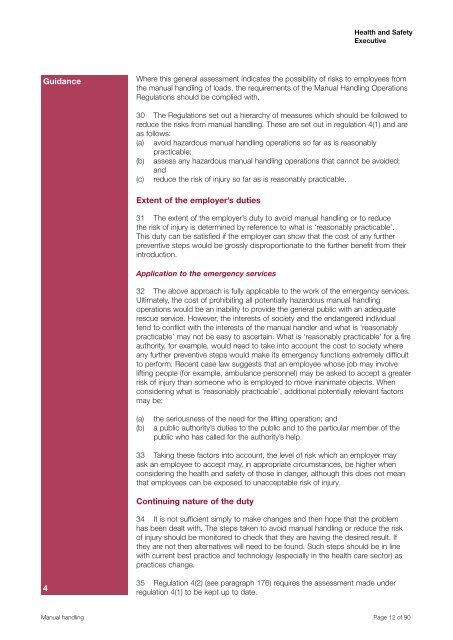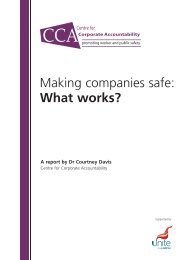Manual Handling Manual Handling Operations Regulations 1992 ...
Manual Handling Manual Handling Operations Regulations 1992 ...
Manual Handling Manual Handling Operations Regulations 1992 ...
Create successful ePaper yourself
Turn your PDF publications into a flip-book with our unique Google optimized e-Paper software.
Health and Safety<br />
Executive<br />
Guidance<br />
Where this general assessment indicates the possibility of risks to employees from<br />
the manual handling of loads, the requirements of the <strong>Manual</strong> <strong>Handling</strong> <strong>Operations</strong><br />
<strong>Regulations</strong> should be complied with.<br />
30 The <strong>Regulations</strong> set out a hierarchy of measures which should be followed to<br />
reduce the risks from manual handling. These are set out in regulation 4(1) and are<br />
as follows:<br />
(a) avoid hazardous manual handling operations so far as is reasonably<br />
practicable;<br />
(b) assess any hazardous manual handling operations that cannot be avoided;<br />
and<br />
(c) reduce the risk of injury so far as is reasonably practicable.<br />
Extent of the employer’s duties<br />
31 The extent of the employer’s duty to avoid manual handling or to reduce<br />
the risk of injury is determined by reference to what is ‘reasonably practicable’.<br />
This duty can be satisfied if the employer can show that the cost of any further<br />
preventive steps would be grossly disproportionate to the further benefit from their<br />
introduction.<br />
Application to the emergency services<br />
32 The above approach is fully applicable to the work of the emergency services.<br />
Ultimately, the cost of prohibiting all potentially hazardous manual handling<br />
operations would be an inability to provide the general public with an adequate<br />
rescue service. However, the interests of society and the endangered individual<br />
tend to conflict with the interests of the manual handler and what is ‘reasonably<br />
practicable’ may not be easy to ascertain. What is ‘reasonably practicable’ for a fire<br />
authority, for example, would need to take into account the cost to society where<br />
any further preventive steps would make its emergency functions extremely difficult<br />
to perform. Recent case law suggests that an employee whose job may involve<br />
lifting people (for example, ambulance personnel) may be asked to accept a greater<br />
risk of injury than someone who is employed to move inanimate objects. When<br />
considering what is ‘reasonably practicable’, additional potentially relevant factors<br />
may be:<br />
(a)<br />
(b)<br />
the seriousness of the need for the lifting operation; and<br />
a public authority’s duties to the public and to the particular member of the<br />
public who has called for the authority’s help.<br />
33 Taking these factors into account, the level of risk which an employer may<br />
ask an employee to accept may, in appropriate circumstances, be higher when<br />
considering the health and safety of those in danger, although this does not mean<br />
that employees can be exposed to unacceptable risk of injury.<br />
Continuing nature of the duty<br />
34 It is not sufficient simply to make changes and then hope that the problem<br />
has been dealt with. The steps taken to avoid manual handling or reduce the risk<br />
of injury should be monitored to check that they are having the desired result. If<br />
they are not then alternatives will need to be found. Such steps should be in line<br />
with current best practice and technology (especially in the health care sector) as<br />
practices change.<br />
4<br />
35 Regulation 4(2) (see paragraph 176) requires the assessment made under<br />
regulation 4(1) to be kept up to date.<br />
<strong>Manual</strong> handling Page 12 of 90
















